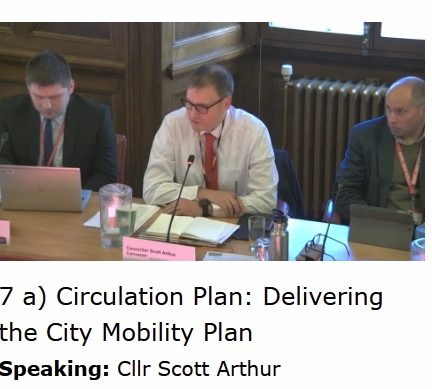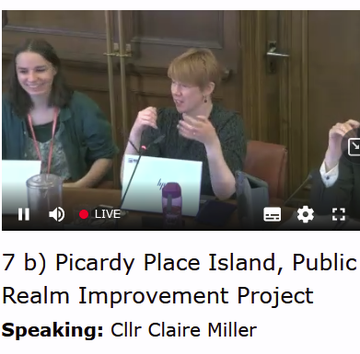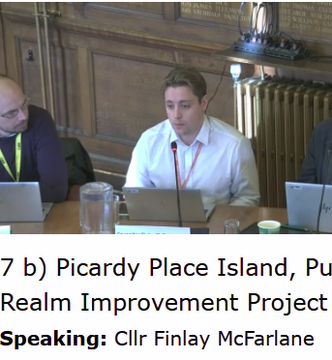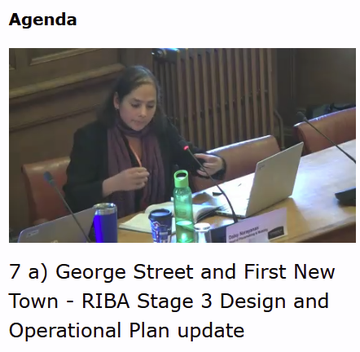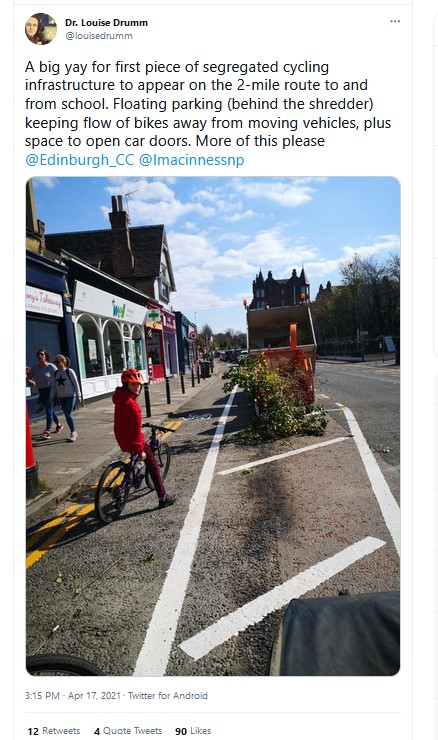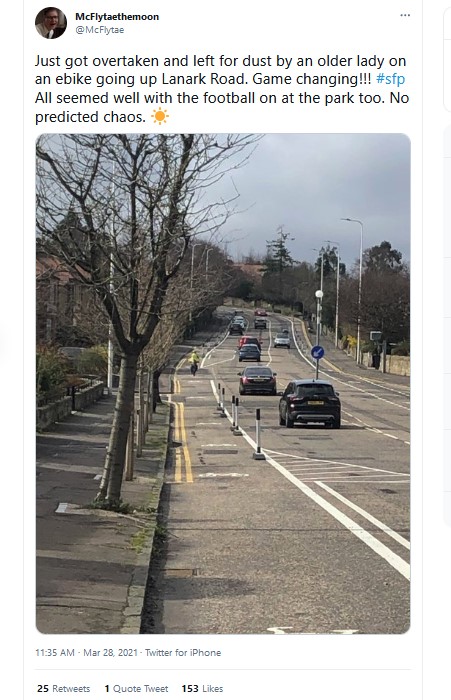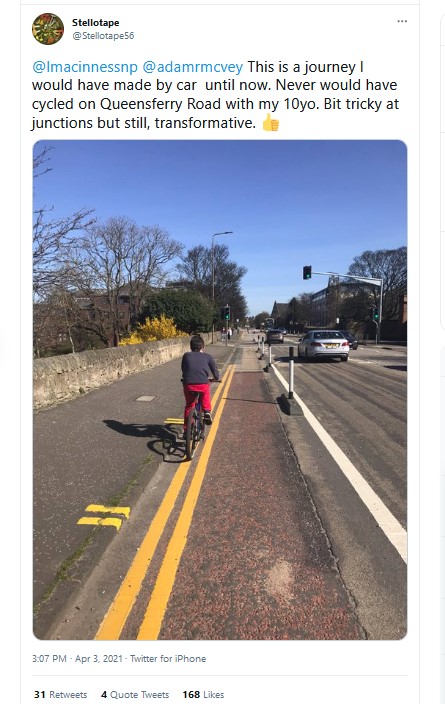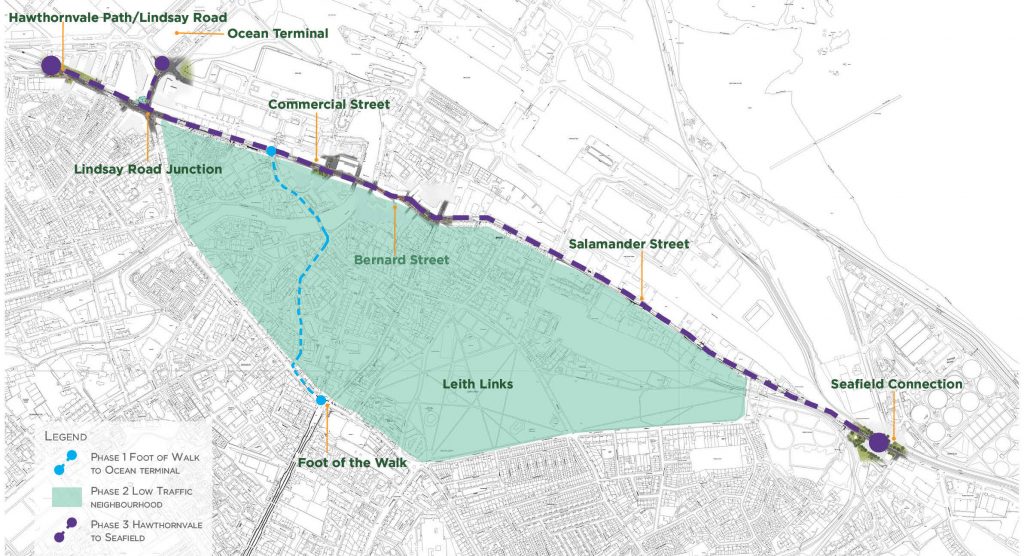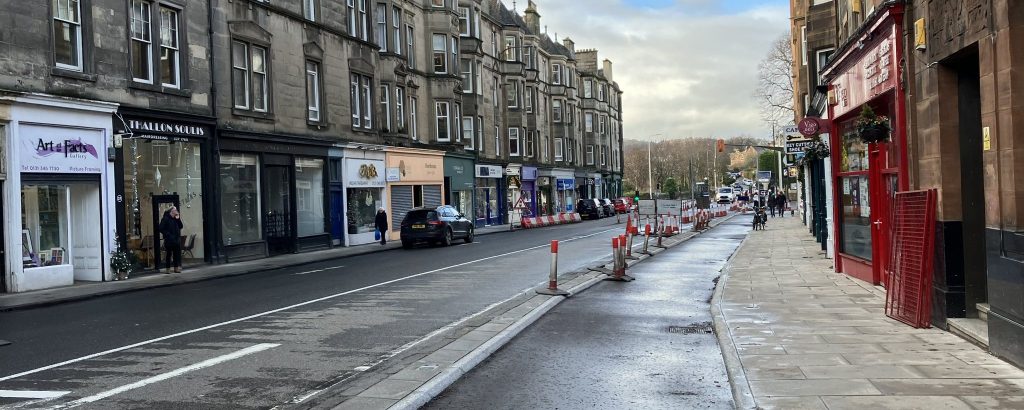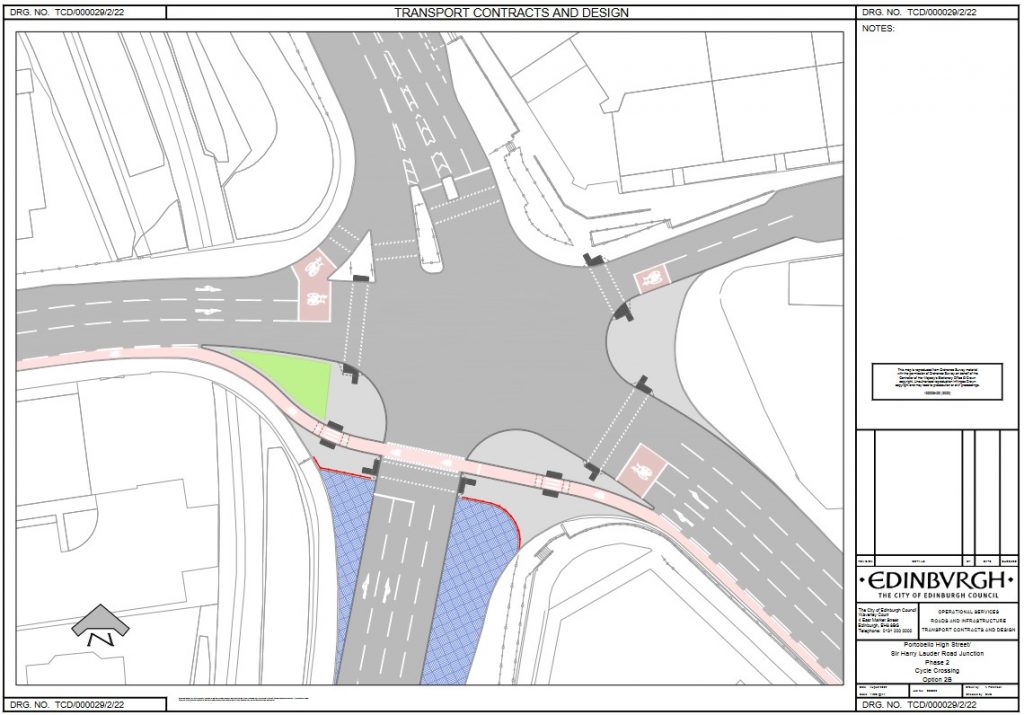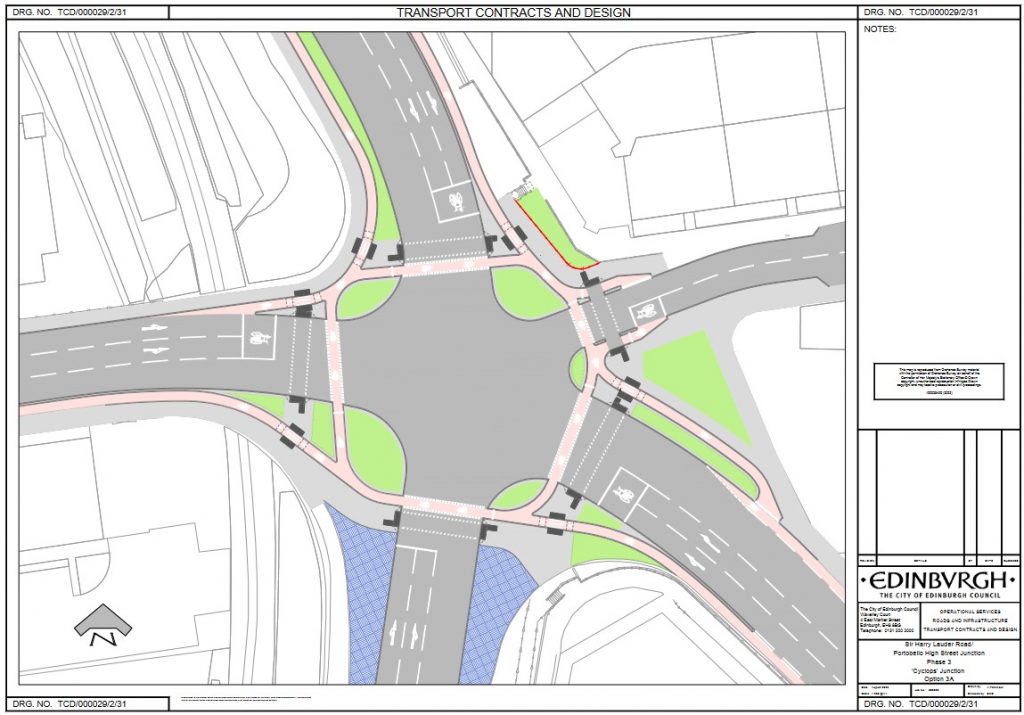What can we expect locally for bike use and wider sustainable transport under Edinburgh’s new minority council? What will Spokes – and you! – need to support, to oppose, to provide, to improve or to highlight in order to encourage and speed up the move towards more sustainable and healthy places to live and get about? This article outlines some topics which we expect to matter locally in 2023 and beyond.
When a new council is elected, the first 6-12 months usually don’t show great change on the ground: budgets are already allocated, contracts are in place, traffic orders and implementation plans are underway. It is difficult to either praise or blame the new administration but, as months pass, its intentions and abilities become clearer.
The first major insights are likely to be the Circulation Plan (see below) and a range of revised policy documents (including the draft Active Travel Action Plan, ATAP) to be published in early February 2023 and then consulted on in one big package rather than the usual ongoing series of separate consultations.
Policies
Minority Council
We are in the unusual (for Edinburgh) position of a minority council, rather than a coalition with an overall majority and an agreed programme.
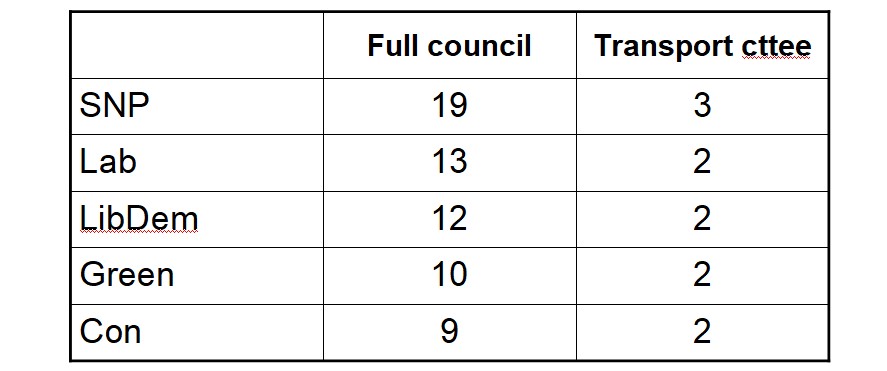
Labour, who run the administration, have just 13 of the 63 council seats, and on the Transport Committee just 2 places out of 11. Whilst Labour chairs nearly all Committees, including Transport, decisions are made by Committee votes, not by the Convener. Conveners are, of course, in constant communication with officers, and are the go-to for the press, and so have a degree of control over the agenda – but they have to come up with proposals which win majority votes at Committee and in the full Council.
Similarly, other parties can put forward proposals, and win a vote, even if the administration has different views. This has already happened on the Workplace Parking Levy (WPL), where Labour was outvoted by a SNP/LibDem/Green combination [see tweets 1 2] asking officers to continue working on proposals. Cllr Arthur then suggested Labour could also support the WPL if their concerns were addressed in the next report. Whether we end up with a WPL, or congestion charging, or even both, remains to be seen.
The WPL vote confirms that whilst the minority Labour adminstration will attempt to implement its manifesto, it can not do so where other parties combine to propose something different – and indeed the Council may implement policies not in the Labour manifesto.
To develop a clear program, Council officers devised a detailed draft Business Plan seeking to combine the best of all manifestos. The Plan includes continued policy development on charging (presumably including road-user charging) and on a WPL, with possible WPL implementation within the next 2 years [appendix 1, section 9e]. At the December 2022 Council meeting the Business Plan was approved by a majority vote, incorporating various addendums and amendments from Labour, Greens, LibDems and Conservatives, although SNP and Greens failed to get other changes adopted.
Early suggestions that the administration was in reality an informal Lab/Lib/Con ‘coalition’ have proved far from the truth, and, in terms of transport, so far, a minority administration appears to work well. The Transport Committee has been remarkably consensual, with different parties often accepting suggestions from others, and ‘best of both worlds’ motions being approved. Instead of the usual rigid ‘administration v. opposition,’ we have seen a variety of party alignments on different issues, for example…
- ETROs – Green/SNP succeeded, beating alternative separate Lab & Lib motions – but Greens agreed to incorporate part of the Lab motion. Con abstained.
- WPL – Labour outvoted by a Lib/SNP/Green alignment, so WPL remains council policy – see above
- Shop trader disruption compensation (which would have set problematic future precedents) – Lab/Green combined against Lib/Con, with SNP abstaining
- Brunstane Road closure – Lab/SNP/Green aligned, Con & Lib opposing.
Circulation Plan
- The new Council is developing a Circulation Plan, to determine which transport modes will have priority on which roads, and to “deal with” rat-running in residential and school areas.
- It is intended to be the “strategic framework for all relevant investment programmes, including the major junctions review, the delivery of Low Traffic Neighbourhoods, the road and footways renewals programme and the citywide roll-out of School Streets“
- This will be the first major policy initiative by the new administration in terms of use of the roads and should give a good insight into their mindset. Cllr Scott Arthur, the Transport Convener has outlined the rationale for the Plan, pointing out that Leith Walk shows what can happen when you try to squeeze too much into a given space [a fair point, though perhaps the main problem in Leith Walk was designing a tramline, then trying to squeeze in the rest, rather than designing holistically from the start]
- The Circulation Plan is still at an early stage: the first reports were in October & December. The second showed “ideal” networks for each mode, then a first iteration of what would be the most important purpose of each stretch of road. The next iteration (February 2023), which will be consulted on, is expected to start getting clearer on what modes would be catered for on each road; and how school and residential areas would benefit.
- Spokes welcomes the concept of the plan, but we have significant concerns, outlined in a deputation to the Transport Committee and then in a more specific subsequent paper. Our two main points are to stress the importance of a cycle network which is open to all – including novices, the less confident, families, etc; and that the plan will require physical measures (such as bus gates and modal filters) to achieve the Council’s 30% traffic reduction target and to make shopping and residential areas pleasant places to walk and cycle.
- Until the Plan becomes more specific, we won’t know the answer to these questions. As SW20Ed put it, the opportunity is huge; the risk is huge. Basically, the Council could be on the way to a citywide network open to all; or it could cement into place a disjointed series of routes, with some sections of top quality and others suitable only for the most confident.
Action Plans
We have not seen a draft of the new Active Travel Action Plan, ATAP, although rumour says it will place strong emphasis on arterial road segregated bike provision. Transport Convener Cllr Scott Arthur has tweeted that it will be “the biggest and boldest in Scotland, and will transform many communities” and, as well as major projects, “will also do things like drop thousands of kerbs.” We wait to see if the reality matches up! We also expect greater emphasis on implementation – partly thanks the disheartening past experience of repeated consultations on unimplemented ‘concepts,’ and also to new government Traffic Order rules simplifying the processes for experimental schemes, and increased government active travel cash.
A new Public Transport Action Plan will also be included in the consultation. There are already signs that buses will get significantly higher priority over private traffic than under the previous Council, as a means to get more people out of cars. For example, the largely buried proposals to make Edinburgh’s bus lanes 7-7-7 (7am-7pm, 7 days a week), on which Spokes campaigned unsuccessfully over several years, have been resurrected [page 11, ‘Bus Lane Operating Hours’][approved at Committee]. Cllr Arthur also told a post-election Spokes public meeting that he had received support from adjacent councils at SEStran for a new approach to commuting – much higher bus priorities into the city, together with congestion charging.
The multi-document consultation in early 2023 is also expected to include a new Road Safety Plan, Parking Action Plan and possibly an updated City Centre Transformation document.
Implementation
Spaces for People / Travelling Safely ETROs
- The new council has commenced the Experimental Traffic Regulation Orders (ETROs) which are now the simplest legal process available to make the 39km of main-road Spaces for People cycle lanes permanent – they were previously legal under time-limited Temporary TROs (TTROs). Under the Scottish Government’s new ETRO rules, there is now a 6-month consultation (ending 20.5.23) during which people can comment, or formally object on these schemes. The Council can then choose to make the schemes permanent, amend them or even scrap them. Clearly they do not want to scrap them wholesale, or would have just let the TTROs expire. ETROs have a maximum life span of 18 months (ending 20.5.24), so the Council must make final decisions before that point is reached.
- Sadly, the Committee reports in 2021 and 2022 proposing to go ahead with the ETROs also included a big disappointment – reopening Braid Road to 2-way traffic, which entailed removing cycle segretation here at the start of the Greenbank to Meadows Quiet Route. Even more disappointingly, not one of the 5 parties on the Transport Committee put forward an amendment at either meeting to retain the Braid Road closure – although, of course, a vote to retain the closure would have required 3 of the 5 parties to agree (barring abstentions). The reports also included partial removal of the downhill Drum Brae North segregation (and indeed it has now all been removed, apparently to facilitate bus diversions during works on Queensferry Road).
- Although it is no consolation, these downgrades continued the pattern of selective removals agreed under the previous council (e.g. protected lanes removed at Forrest Road, George IV Bridge, The Mound, Morningside Road, etc; and the reopenings of Warriston Road and Links Gardens). However Braid Road and Drum Brae remain under the ETROs and so are open to objections calling for reinstatement (do it now!). Forrest Road, George IV Bridge and The Mound will return to bike & pedestrian friendliness under the MGS project, and Links Gardens is now being reconsidered in the Leith Connections LTN.
Low Traffic Neighbourhoods
- Work due to begin on Corstorphine LTN on Jan 23
- Leith Connections is a 3-part project including
- phase 1: cycleroute from Foot of Walk to Ocean Terminal, avoiding the tramlines. The legal Orders process is underway, with construction hoped to start in 2023, as long as the Scottish Govt does not set up an inquiry into any unwithdrawn objections
- phase 2: Leith LTN, road closures, bus gate, planting, seating, etc. To implemented via ETROs, so that the final design can be modified on the basis of experience. Work due to begin Spring 2023
- phase 3: cycleroute connecting North Edinburgh Network to Portobello – plans still at consultation stage.
- Further proposed LTNs are expected to be revealed with the next iterations of the Circulation Plan (above).
CCWEL, City Centre West-East Link
- This major project, gestated over the previous two councils, and with literally years of delay (not all the Council’s fault) is now well under way and the bulk of the route will be open in 2023
- Whilst CCWEL has flaws, it is a good starting point and a marked contrast with the design problems which have plagued the Leith Walk segregated cycleroutes (below). There are several reasons for the difference, but in particular CCWEL was designed and implemented by the Council’s own active travel team, and they consulted on the detail of the scheme; whereas Leith Walk was designed and implemented by the arms-length ‘Trams to Newhaven’ body, and who consulted only minimally on the design details.
- Our concerns over CCWEL include…
- The George Street section now falls under a separate project, with a central ‘cycle street’ rather than segregated lanes. However, this still has a lot of question marks over what vehicles will be allowed and when, and how access will be controlled. Ensuring a genuine ‘cycle street,’ which people of all ages and confidences are happy to use, will be a major test for the new administration
- Although CCWEL includes significant direct main-road sections, Spokes has always argued that the ideal route would have continued directly along the main road through Haymarket and Shandwick Place, to and along Princes Street.
- As with all of the tram extension detail, integration of CCWEL has been very disappointing. To cycle from CCWEL and then down Leith Walk on segregated provision entails a diversion through light controlled crossings over Leith Walk and then back again, despite our efforts. With the works now largely complete, we hope as a last resort to persuade the new council to at least include a direct link for the more confident, albeit non-segregated.
- Providing a connection from south Edinburgh to CCWEL and the City Centre is the Meadows to George Street project. It includes substantial changes to traffic patterns, including bus gates at Bank Street and on Market Street (at its junction with Jeffrey Street). Unlike CCWEL, MGS did not suffered major unavoidable delays; but its planned timetable was ridiculously long, with initial proposals in 2017, followed by multiple ‘concept’ consultations, and construction still not due to start until 2024.
Portobello/ Sir Harry Lauder Road junction
- The site of 2 cyclist deaths in recent years, this complex and dangerous junction had short-term cycle safety measures implemented in autumn 2022, with medium term set to follow in late summer 2023. These are designed to form part of a subsequent major junction redesign (requiring Traffic Orders), possibly also incorporating main road radial cycle routes radiating out from the junction. A huge amount of effort by Spokes Porty has gone into working with and encouragin the Council on these solutions
- The long term solution is also part of a Council Major Junctions Review, to “improve safety for vulnerable road users at the city’s major junctions.”
Leith Walk
- Sadly, the Council did not learn from the first tramline. The purpose of the Council’s project team, Trams to Newhaven, appears to be to install a tramline and try to fit everything else around it, rather than planning holistically for a transport corridor
- The initial plans were utterly disastrous for cycling, including an onroad section comprising one all-traffic lane squeezed between loading spaces and tramlines. After a major revolt and subsequent consultation the Council agreed to reduce the car running/parking lanes from two to one in the narrow section, with segregated bike lanes and improved footways the whole length of the Walk
- Sadly, whilst the principle of segregated lanes was indeed implemented, there was minimal consultation by Trams to Newhaven on the detailed design of both cycleways and footways, and the outcome has been exceptionally disappointing. Notable failures include kerbs too shallow (25mm or less) for blind people to easily identify (we have lobbied jointly with the Access Panel on this); very bumpy surfacing (despite our highlighting the issue from the outset, given the unfortunate Buccleuch Street precedent); and a non-direct connection from CCWEL to Leith Walk downhill (see above). We are told that any flaws which do not meet Council ‘street design’ standards have to be rectified by the contractor, but the delays suggest internal disagreements on this. The final outcome is still unclear, but will certainly not be all we had hoped when segregated provision was agreed.
Parking enforcement
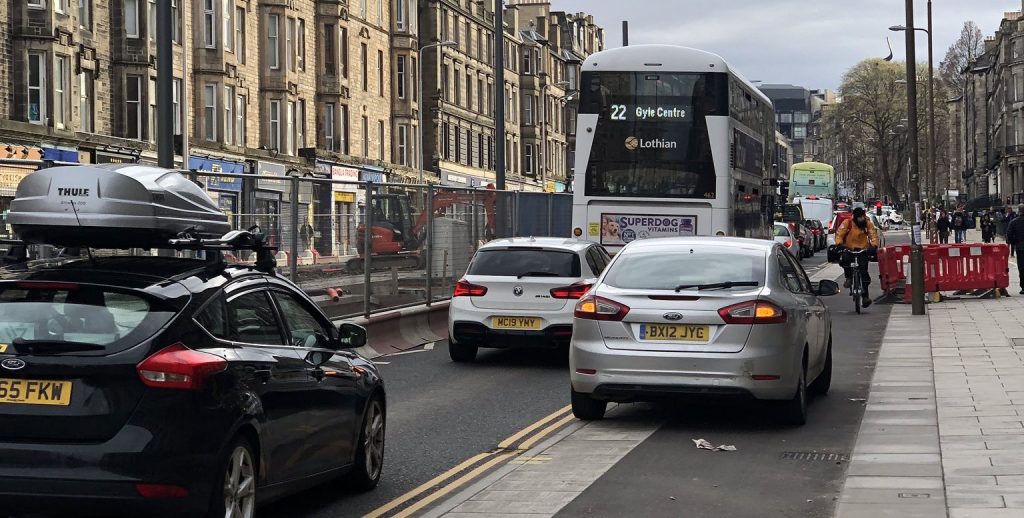
- Inadequate parking enforcement on cycleways, footways and bus lanes is a huge bugbear and often a serious danger for people on bikes or on foot, but Councils are limited in what they can do
- The Pavement Parking Act, passed in 2019, has still not been put into force by the Scottish Government, and on current intentions will not be so until 2024
- Automatic number-plate recognition (ANPR) cameras legally cannot be used for prosecutions – the Scottish Government has still not permitted this
- At the December 2022 Transport Committee, Cllr Scott Arthur proposed a successful motion to tighten up enforcement, as far as the Council is able urgently, by abolishing the requirement for traffic wardens to wait before issuing a penalty, and by tightening the definition of persistent offenders. Further measures are expected in a Parking Action Plan in February
- What puzzles many people is why the Council does not use physical protection – for example bollards – more widely. Sheffield/Edinburgh racks for bike parking can be (and are) used in the same way!
Bike hire / bike storage
- The continued absence of a city bike hire scheme is a major problem for a city with an ambition to cut car-km 30% by 2030, or to be seen as a flagship cycling council. A report to Committee is expected in early 2023, but funding appears to be a big sticking point.
- There is better news on secure bike storage, with 70 or so further 6-bike ‘hangar‘ installations in 2023 and a funding application for 200 more [page 8]
Not forgetting…
Volunteer support
2022 saw continued mushrooming in citizen and 3rd sector campaigning for a quality cycle network, suitable for all ages and abilities, and we expect this to grow further in 2023. Please join in!
- Spokes Planning Group continues its work monitoring and responding to Council and Government policies, actions and consultations. For example. We’re short of members with time and interest to draft these responses – please do get involved if you can help – meetings are online, roughly monthly
- Spokes Porty and Spokes South Edinburgh continue their local activity; with Porty having put huge effort into the Sir Harry Lauder Road junction and South Ed into Braid Road (more on both issues above)
- South West Edinburgh 20 Minute Neighbourhoods is making a big impact not just in its area, but also across the city, with highly researched blogs, and outreach such as free cargobike hire
- Infrasisters, with its mass lit-up evening rides, highlights the necessity of infrastructure which is safe and welcoming for all, and particularly women at night
- Bike Buses are appearing in more schools, including Blackford Safe Routes, Juniper Green Primary, George Watsons, Sciennes Primary, Corstorphine Primary, … Recognising the growth and future potential, Green councillor Jule Bandel put forward a successful Transport Committee motion asking officers to offer all primary schools information and support to set up local bike buses – the motion was widened by input from other parties, for example to include walking buses
- Cargobikes are being seen more and more on Edinburgh’s streets, both as family transport and for local deliveries, and are increasingly available in local shops including LaidBack Bikes, Harts Cyclery and Edinburgh Bicycle. Innovative organisations here include CargoBikeMovement and FarrOut Deliveries, both of whom Spokes has supported in small ways. Thanks to kind donations by our members, sales of our maps, and Galashan Trust support, Spokes offers grants towards the cost of a cargobike for local organisations and microbusinesses (Edinburgh & Lothians only) and, from time to time, to Spokes member households. See.. Info .. Pictures & reports
- Better Edinburgh for Sustainable Transport, BEST, founded at height of the Spaces for People controversies, links many of the groups here across the city, for discussion and occasional joint initiatives
- City Cycling Edinburgh is the most widely known, active, and venerable discussion forum on local cycling (and related) issues, and is accompanied by a very active twitter account
- Critical Mass Edinburgh is flourishing, with big attendances and impressive organisation, so that the participants, of all ages and confidences, can feel safe using the city streets – at least for an hour or two each month!
- Car Free Holyrood continues to campaign for a safer, greener park, free from through motor traffic. This included a Transport Committee deputation in December 2022. The Park is of course operated by Historic Scotland, but in the subsequent discussion, Convener Cllr Scott Arthur said a road would never be built there nowadays, and through traffic must eventually be removed.
Scottish Government
- Our article is primarily about local policies, developments and activities, but they all fall within the context of Scottish Government policies, which greatly affect what councils can do, and what restrictions are placed on them
- Scottish Government funding is on a hugely welcomed big upward slope (largely due to climate target imperatives) – though not quite on the trajectory we had hoped and even expected. See our budget 23/24 report (and retweet our tweet)
- Given this major funding boost, Scot Govt is in the process of reorganising processes to ensure the cash is used as effectively as possible, through Cycling Framework and Active Travel Transformation initiatives. These are covered in our budget article.
- Many existing government policies restrict Councils’ ability to act rapidly and effectively to promote cycling and wider active and sustainable travel. As part of the above government Transformation initiative, councils have been asked to identify such restrictions, with a view to relieving them. A few examples: allowing bus ANPR cameras to issue automatic fines for parking in bus lanes; allowing councils to increase fines for parking infringements; further changes to the rules on Traffic Orders, to make project implementations easier (like in England); speeding up implementation of the act to ban pavement parking, drop-kerb parking and double parking. A successful example, in which Spokes played a large part over many years, was the government decision to allow householders to install modest front-garden bike sheds without seeking planning permission.
What you can do
- Contact your councillors and/or MSPs about issues in this article. Find them at www.writetothem.com. Or: Edinburgh Council / Scottish Government. Send us any useful replies. Meeting your representative(s) in person or online when you feel strongly about something can be even more useful than email – try it!
- Join Spokes – it is certainly not necessary to be an ‘activist’ though we particularly need members with the time and interest to help in our responses to local and/or national consultations etc
- Retweet our tweet of this article.

